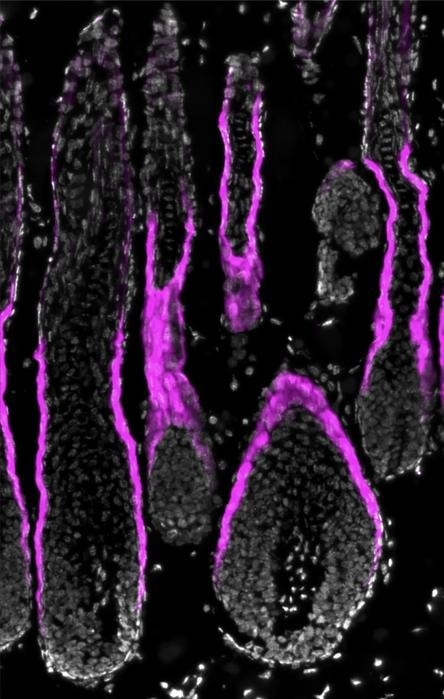Scientists have, for the first time, demonstrated the presence of hemoglobin—a protein primarily known for its role in binding with oxygen within red blood cells—in the epidermis, the outermost tissue layer of human skin.
 Hemoglobin α (magenta) in mouse hair follicles during the growth phase of hair cycles. Image Credit: Umi Tahara, Takeshi Matsui, Keitaro Fukuda, and Masayuki Amagai.
Hemoglobin α (magenta) in mouse hair follicles during the growth phase of hair cycles. Image Credit: Umi Tahara, Takeshi Matsui, Keitaro Fukuda, and Masayuki Amagai.
The study, published in the Journal of Investigative Dermatology by Elsevier, provides crucial insights into the epidermis’s characteristics as the skin’s protective outer layer. Investigating the epidermis's role in environmental protection, the research aimed to identify unexpected molecules within this layer.
The investigation revealed hemoglobin α protein not only in the keratinocytes of the epidermis but also in hair follicles, marking a surprising discovery that adds a new dimension to our understanding of the skin’s protective mechanisms. The research was conducted in part by scientists associated with the Laboratory for Skin Homeostasis at the RIKEN Center for Integrative Medical Sciences in Yokohama.
The epidermis consists of keratinized stratified squamous epithelium, which is primarily composed of keratinocytes. Previous studies have identified the expression of various genes with protective functions in keratinocytes during their differentiation and formation of the outer skin barrier. However, other barrier-related genes escaped prior detection because of difficulties obtaining adequate amounts of isolated terminally differentiated keratinocytes for transcriptome analysis."
Masayuki Amagai M.D., Ph.D., Study Lead Investigator, Department of Dermatology, School of Medicine, Keio University
The study found that epidermal hemoglobin functions as a binding agent for gases such as oxygen, carbon dioxide, and nitric oxide and acts as an iron carrier via the heme complex. These properties suggest that epidermal hemoglobin could play a role in antioxidant activity and potentially contribute to other aspects of barrier function.
We conducted a comparative transcriptome analysis of the whole and upper epidermis, both of which were enzymatically separated as cell sheets from human and mouse skin. We discovered that the genes responsible for producing hemoglobin were highly active in the upper part of the epidermis. To confirm our findings, we used immunostaining to visualize the presence of hemoglobin α protein in keratinocytes of the upper epidermis."
Masayuki Amagai M.D., Ph.D., Study Lead Investigator, Department of Dermatology, School of Medicine, Keio University
Amagai noted, “Our study showed that epidermal hemoglobin was upregulated by oxidative stress and inhibited the production of reactive oxygen species in human keratinocyte cell cultures.
“Our findings suggest that hemoglobin α protects keratinocytes from oxidative stress derived from external or internal sources such as UV irradiation and impaired mitochondrial function, respectively. Therefore, the expression of hemoglobin by keratinocytes represents an endogenous defense mechanism against skin aging and skin cancer,” concluded Amagai.
Source:
Journal reference:
Tahara, U., et al. (2023) Keratinocytes of the Upper Epidermis and Isthmus of Hair Follicles Express Hemoglobin mRNA and Protein. Journal of Investigative Dermatology. doi.org/10.1016/j.jid.2023.08.008.